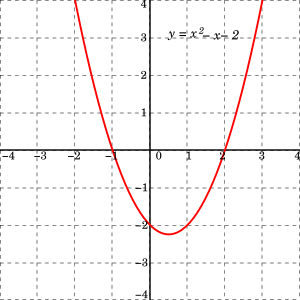QUADRATIC EQUATIONS
THE EQUATION IN THE FORM OF IS CALLED QUADRATIC EQUATION. WHERE a, b AND c ARE CONSTANT.SOLUTION OF QUADRATIC EQUATION IS GIVEN BY.

Meaning of the root of the equations in geometric term:
The roots of the quadratic equations represent, since the quadratic equation represent the equation of parabola. hence the root of the quadratic equations where the parabola cut the x-axis.
in the given below the curve of parabola cut the x-axis at x= -1 and 2 hence the -1 and 2 are the roots of the equations

Thus according to the value of the (b²-4ac) there can be three conditions are possible:
1. If (b²-4ac)>0
then roots are real and distinct
and the parabola cut the axis at two points

2. If (b²-4ac)=0
then the roots are real and equal
hence the parabola touch the axis

3. If (b²-4ac)<0
then the roots are imaginary
hence the parabola not cut or touch the axis.

For Example:
Solve x2 + 3x – 4 = 0
Factor method
x²+3x-4=0
using facorization method
x²+4x-x-4=0
x(x+4)-1(x+4)=0
(x-1)(x+4)=0
x=1 and x=-4
What is the root of ?
x²+5x+6=0
What is the root of ?
x²+5x+6=0
using factor method
x²+3x+2x+6=0
now taking the x common from first two term and 2 from last two term
x(x+3)+2(x+3)=0
taking (x+3) common
(x+3)(x+2)=0
x=-2 and x=-3
hence the root of quadratic equation are -2 and -3
What is the value of x in the equation
What is the value of x in the equation
Since x=1 is satisfying the equation x³-6x²+11x-6 hence x=1 is the root of the equations
i.e.
x³-6x²+11x-6=1³-6×1²+11×1-6=0
hence divide equation by (x-1)
i.e.
x-1⟦x³-6x²+11x-6⟧x²-5x+6
x³-x²
——
-5x²+11x-6
-5x²-5x
————
6x-6
6x-6
—————
0
i.e.
x³-6x²+11x-6=(x-1)(x²-5x+6)
=(x-1)(x²-3x-2x-6)
0=(x-1)(x-2)(x-3)
hence
x=1, x=2 and x=3
If one root is equal to the square of the other root of the equation x^2 + x - k = 0, what is the value of k?
Given equation
If one root is equal to the square of the other root of the equation x^2 + x - k = 0, what is the value of k?
Given equation
x²+x-k=0
Let one of the root is α then other root will be α²
Now,
sum of root(α+α²)=-1
product of roots α³=-k
then α=-k
and
k+k²=-1
k²+k+1=0
k=-1±√(1-4)/2
k=-1±√3i/2
hence the value of k are -1+√3i/2 and -1-√3i/2
Note: Value of k are imaginary.
If 1-i is one root then other root will be 1+i because roots are imaginary
Now
sum of roots=1-i+1+i=-a
i.e. a=-2
and
product of roots=(1-i)(1+i)=(1-i²)
=1+1=2=b
b=2
1. Solve for x
x²=2x+1
x²-2x-1=0
x²-x-x-1=0
x(x-1)-1(x-1)
(x-1)(x-1)=0
x=1,1
2. Solve for x
2x²+7x+6=0
2x²+4x+3x+6=0
2x(x+2)+3(x+2)=0
x=-2 and x=-3/2
3. If sin C and cos C are two roots of the quadratic equation 2x^2-px+1=0 where 0<c<π/2, then how many possible values can p have?
2x²-px+1=0
3. If sin C and cos C are two roots of the quadratic equation 2x^2-px+1=0 where 0<c<π/2, then how many possible values can p have?
2x²-px+1=0
roots are sinx and cosx
sum of roots sinx+cosx=p/2
and product sinx cosx=1/2
sinx+cosx=p/2
squaring on both sides
sin²x+cos²x+2sinx cosx=p²/4
1+2sinx cosx=p²/4
1+2×(1/2)=p²/4
2=p²/4 or p²=8
p=2√2 and p=-2√2
If the quadratic equation ax²-bx+3=0 and x²-4x+1=0 have a common root, then what is the area of rectangle having sides a and b?
ax2-bx+3=0 and x2-4x+1=0
let the root are x and y
then x+y=b/a and x+y=4
and x+y=3/a and xy=1
now solve for x and y
then a and b\
now area of rectangle is a×b
 IS CALLED QUADRATIC EQUATION. WHERE a, b AND c ARE CONSTANT.
IS CALLED QUADRATIC EQUATION. WHERE a, b AND c ARE CONSTANT.


No comments:
Post a Comment